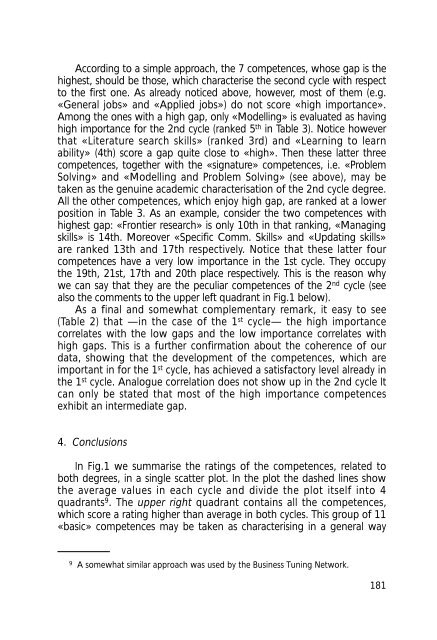Final Report Pilot Project - Relaciones Internacionales de la ...
Final Report Pilot Project - Relaciones Internacionales de la ...
Final Report Pilot Project - Relaciones Internacionales de la ...
Create successful ePaper yourself
Turn your PDF publications into a flip-book with our unique Google optimized e-Paper software.
According to a simple approach, the 7 competences, whose gap is the<br />
highest, should be those, which characterise the second cycle with respect<br />
to the first one. As already noticed above, however, most of them (e.g.<br />
«General jobs» and «Applied jobs») do not score «high importance».<br />
Among the ones with a high gap, only «Mo<strong>de</strong>lling» is evaluated as having<br />
high importance for the 2nd cycle (ranked 5 th in Table 3). Notice however<br />
that «Literature search skills» (ranked 3rd) and «Learning to learn<br />
ability» (4th) score a gap quite close to «high». Then these <strong>la</strong>tter three<br />
competences, together with the «signature» competences, i.e. «Problem<br />
Solving» and «Mo<strong>de</strong>lling and Problem Solving» (see above), may be<br />
taken as the genuine aca<strong>de</strong>mic characterisation of the 2nd cycle <strong>de</strong>gree.<br />
All the other competences, which enjoy high gap, are ranked at a lower<br />
position in Table 3. As an example, consi<strong>de</strong>r the two competences with<br />
highest gap: «Frontier research» is only 10th in that ranking, «Managing<br />
skills» is 14th. Moreover «Specific Comm. Skills» and «Updating skills»<br />
are ranked 13th and 17th respectively. Notice that these <strong>la</strong>tter four<br />
competences have a very low importance in the 1st cycle. They occupy<br />
the 19th, 21st, 17th and 20th p<strong>la</strong>ce respectively. This is the reason why<br />
we can say that they are the peculiar competences of the 2 nd cycle (see<br />
also the comments to the upper left quadrant in Fig.1 below).<br />
As a final and somewhat complementary remark, it easy to see<br />
(Table 2) that —in the case of the 1 st cycle— the high importance<br />
corre<strong>la</strong>tes with the low gaps and the low importance corre<strong>la</strong>tes with<br />
high gaps. This is a further confirmation about the coherence of our<br />
data, showing that the <strong>de</strong>velopment of the competences, which are<br />
important in for the 1 st cycle, has achieved a satisfactory level already in<br />
the 1 st cycle. Analogue corre<strong>la</strong>tion does not show up in the 2nd cycle It<br />
can only be stated that most of the high importance competences<br />
exhibit an intermediate gap.<br />
4. Conclusions<br />
In Fig.1 we summarise the ratings of the competences, re<strong>la</strong>ted to<br />
both <strong>de</strong>grees, in a single scatter plot. In the plot the dashed lines show<br />
the average values in each cycle and divi<strong>de</strong> the plot itself into 4<br />
quadrants 9 . The upper right quadrant contains all the competences,<br />
which score a rating higher than average in both cycles. This group of 11<br />
«basic» competences may be taken as characterising in a general way<br />
9 A somewhat simi<strong>la</strong>r approach was used by the Business Tuning Network.<br />
181


